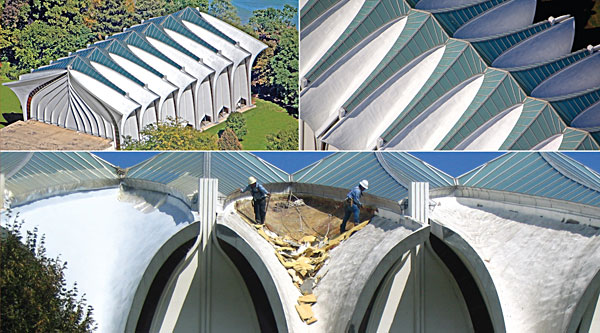Roofing Strategies Reach New Heights: Sustainable Options for a Key Building Element
Polyurethane Foam and Topcoats: Protecting the Roof
Another sustainable, water-based, roofing system is a topcoated spray-applied polyurethane foam (SPF) system. Dating from the 1960's, SPF roofs are monolithic, fully adhered and self-flashing, that is the polyurethane foam can be used to form its own flashing so no separate flashing materials are required.
SPF conforms to any surface profile to form a tough, waterproof membrane, offering the highest R-Value of any commercially available insulation material. Spray-applied as a two-component liquid, it expands to 30 times its fluid thickness to form a seamless, dimensionally stable blanket over new or existing roof substrates including metal, wood, concrete and built up roofing. "SPF is a good choice when extra insulation is needed, as there is an increase of R 6 to 7 per inch of foam," says Quest Construction Products' Vice President/Business Unit Manager Charlie Van Gelder. He adds that SPF is suitable for use in areas with severe temperatures and/or high winds, as well as for correcting roofs with ponding water problems. "The slope can be built up in to add slope where necessary until the proper drainage is achieved," Van Gelder says, noting that a quality applicator can apply the foam so that it forms a relatively smooth surface, with smooth transitions to details such as flashings and drains. Wind screens can be used to prevent overspray under moderate wind conditions.
Studies have indicated that cured spray polyurethane foam is relatively inert and does not release toxic gases or leach harmful chemicals into the atmosphere or soil. Two separate studies report that the effectiveness of an SPF roof did not diminish over time. A 1996 study for the National Roofing Foundation of 1,600 SPF roofs - with the oldest roofs being more than 30 years old - found that 97.6 percent of the roofs did not leak, 93 percent had less than 1 percent deterioration, and 55 percent required no maintenance.
Topcoating the SPF with an elastomeric coating, typically acrylic, silicone, polyurethane, or aggregate covering, is a must to protect it from UV degradation. Topcoats also work to reduce moisture vapor transmission, increase the roof system's resistance to impact, achieve fire rating code requirements and enhance aesthetics.
SPF roofing systems can be particularly effective, and relatively easy to apply, on roofs of elaborate design or numerous penetrations. The unique roof of the North Shore Congregation Israel in Glencoe, Illinois, built the 1960's, features varying angles and slopes with several rooftop skylights. Upon aging of the original topcoated SPF system, the synagogue opted to replace it with a similar combination of foam and coatings. After the old materials were removed, the building's concrete roof deck was exposed and cleaned, followed by application of the SPF system. Two layers of elastomeric acrylic basecoat were applied over the foam at a rate of 1.5 gallons per 100 square feet each. Two separate coats of a weather resistant fluoropolymer topcoat were then applied at the rate of 1/2-gallon per 100 square feet per coat.
 |
Topcoated SPF was an ideal solution for the roof of the North Shore Congregation Israel, Glencoe, IL. Top images: After shots; Bottom image: During construction. Photos courtesy of Insulated Roofing Contractors of Louisville, KY |
Â
An SPF system also made sense at the massive MGM Grand Hotel and Casino in Las Vegas, where high temperatures and heavy maintenance had taken a toll on the 214,000-square-foot black EPDM (ethylene propylene diene terpolymer) rubber roof. An SPF roof was installed over the existing substrate and topcoated with a protective acrylic membrane, which provides high-build durability and waterproofing. A reflective fluoropolymer topcoat was added to aid in dirt pick-up resistance and improve durability under foot traffic. Fluoropolymer refers to a type of chemical composition that is a more UV- stable polymer than acrylics or polyurethanes.









